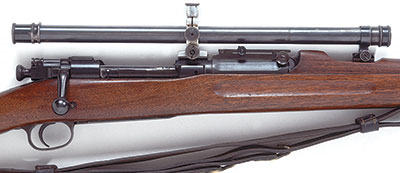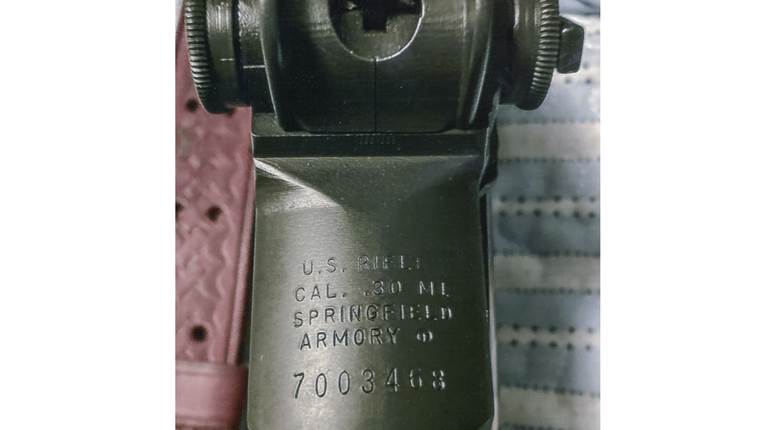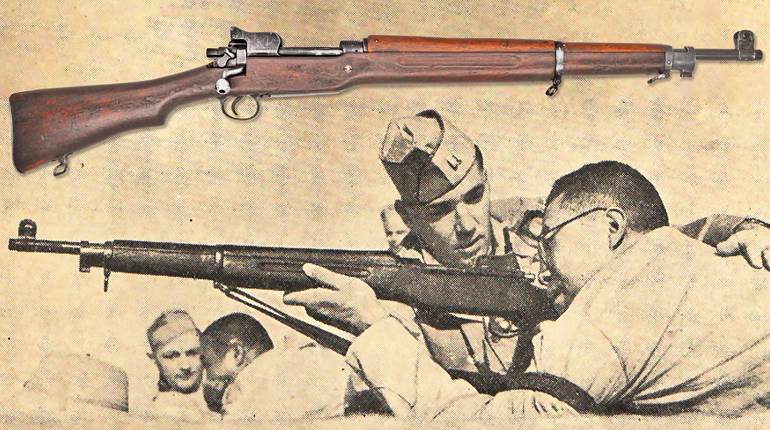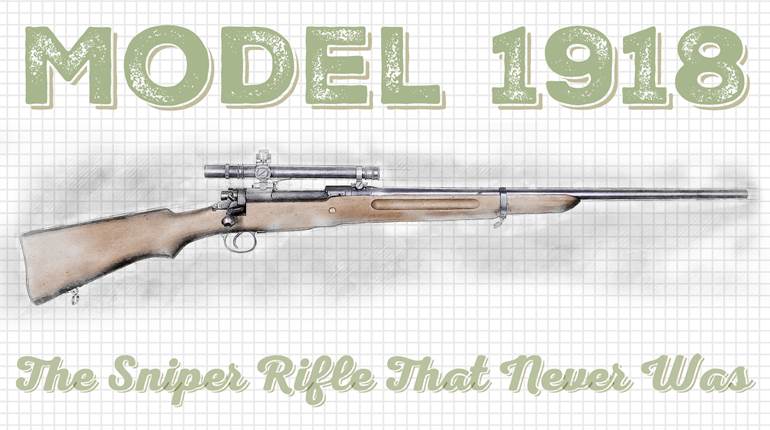
U.S. M1903 Springfield rifles fitted with optical sights were the primary U.S. sniper rifles of World War I. Shown here are (l. to r.): an M1903 with a Winchester A5 scope; an M1903 with an M1913 Warner & Swasey Musket Sight; and an M1903 with an M1908 Warner & Swasey Musket Sight. Arms and accoutrements from the Bruce N. Canfield collection. The M1903 with a Winchester A5 was the standard USMC sniper rifle of World War I as demonstrated by the period image of a Marine sergeant at left.
This article was first published in American Rifleman, September 2000
Rifles fitted with telescopic sights were used in warfare long before World War I. Some amazing feats of marksmanship were reported during the American Civil War with the surprisingly accurate muzzleloading target rifles of the day. Those were civilian production arms, however, and were not officially adopted by the government.
Until the Krag-Jorgensen rifle was adopted in 1892, little experimentation had been performed by the U.S. military on telescopic-sighted rifles. In 1900, three U.S. Model 1898 Krag rifles were fitted with telescopes manufactured by the Cataract Tool & Optical Co. A subsequent Ordnance Department report recommended that the Krag/Cataract rifles be thoroughly field-tested. Development of an improved rifle resulted in the now legendary “U.S. Model of 1903” or the ’03 Springfield—a Mauser-based turnbolt that saw more than 30 years of production. The ’03’s replacement of the Krag just after the turn of the century resulted in suspension of any extensive field testing or further development work on the proposed “sniper rifle.” In the U.S. Army of the day, snipers were often called “sharp shooters.”
The static trench warfare that characterized much of the fighting on the Western Front from 1914 to 1918 proved to be tailor-made for sniping on both sides. The fact that the trenches of the opposing sides were often only a few hundred yards (or less) apart meant that snipers could be utilized to harass and intimidate the enemy. Sniping evolved into something of an art during World War I, and numerous casualties were inflicted upon soldiers who carelessly peered over the trench parapets. Each side was forced to employ snipers as both an offensive and defensive tool. Snipers became feared and hated opponents, and any that were unfortunate enough to be captured during a trench raid often met an ignoble end.
U.S. Model 1903 Springfield Sniper Rifles
Soon after the bolt-action .30-cal. U.S. M1903 Springfield was adopted and put into production, the Ordnance Department began developmental work on a telescopic-sighted version of the new rifle. The Small Arms Firing Regulations of 1904 authorized the issue of telescopic sights to specially designated marksmen. As stated in Chapter II, Section 235 of the Regulations:
“Telescopic Sight—To encourage efforts, to award efficiency, and to properly equip a special class of shots who shall not only be designated as expert, but who, in action, shall be employed as such, the telescopic sight is adopted. These sights will be supplied by the Ordnance Department and assigned to enlisted men who have qualified under these regulations as expert riflemen. They will be issued to and accounted for by the company commander, and, in his discretion, may be carried by the men at inspection under arms.”

Warner & Swasey Musket Sights Model Of 1908
Although the Small Arms Firing Regulations of 1904 and 1906 stated that “the telescopic sight is adopted,” none were on hand. The Ordnance Department evaluated several rifle telescope designs and eventually settled on a rather unusual scope developed by the Warner & Swasey Company of Cleveland, Ohio. Warner & Swasey was a well-known entity to the Ordnance Department and had previously supplied artillery fire-control equipment and optical instruments to the government. Twenty-five of the Warner & Swasey telescopes were purchased in 1906 and fitted to M1903 rifles for testing. The experimental W&S telescope was a prismatic design that allowed for a wide field of view for the then relatively high power (6X) of the scope. The scope was attached to the M1903 rifle by means of a dovetail base fastened to the left side of the receiver. A spring-loaded plunger held the scope to the base and allowed it to be removed easily from the rifle. The mounting location permitted loading and firing with stripper clips and allowed the standard iron sights to be used with the scope in place. Its offset from the bore line, however, required that the shooter assume a somewhat awkward firing position. No alterations of the standard M1903 rifle were necessary, except for attachment of the receiver base and the removal of a small portion of wood on the left side of the stock to provide the necessary clearance.
The experimental Warner & Swasey scope was tested by the Ordnance Department and found to be satisfactory for service use. The very high price of the scope, about $80 per unit, was nearly double the cost of an ’03 rifle and was deemed excessive. This dissatisfaction with the price of the scope resulted in the company modifying the design a bit, and the price was reduced to a satisfactory level.

In 1908, the modified Warner & Swasey scope was officially adopted as “Telescopic Musket Sight, Model of 1908.” The M1908 W&S scope was made of black-painted steel and brass, and weighed a substantial 21⁄4 lbs. Warner & Swasey markings and a sight serial number were stamped on the left side. Two brass plates containing firing and sight adjustment data were attached to the top of the sight. The sight had a crosshair reticle and three stadia lines for estimating distance. The short eye relief of the sight required a rubber eyepiece, made of green-tinted rubber, to properly position and protect the shooter’s eye.

One thousand M1908 W&S sights were procured in 1909, 10 were purchased in 1910 and the final acquisition of 1,065 sights occurred in 1912. The W&S sights were fitted to specially selected M1903 rifles at Springfield Armory. The serial number of the rifle to which a sight was mated was stamped inside of the sight’s dovetail recess. Rifle serial numbers were generally in the 340,000 to 500,000 range. Regulations called for matched rifles and scopes to be kept together as a unit at all times. That was rarely done, however, and the rifles and scopes soon became mismatched in service. The M1908 W&S sights were issued with a leather carrying case with cartridge belt hooks and a shoulder strap. The case had a leather cover flap secured by a buckle. A metal adjustment wrench was carried in a pocket located inside the cover flap. The cases were manufactured by Rock Island Arsenal.
Those M1903 rifles fitted with the new Warner & Swasey “musket sights” were likely something of a novelty to the marksmen not accustomed to telescopic sights. It soon became obvious that the W&S design was not a very good telescope, and myriad problems were encountered. The prismatic design meant that any specks of dirt or flecks of paint that found their way inside the scope were magnified six times in the sight picture. Also the short eye relief, rubber eyepiece and awkward shooting posture were not conducive to good marksmanship. As W.C. Crossman put it in his classic Book of the Springfield, the Warner & Swasey sight could “ … make a flincher out of a cigar store Indian.”

Warner & Swasey Musket Sight Model of 1913
The complaints lodged against the M1908 W&S sight resulted in a redesigned variant that was adopted as “Telescopic Musket Sight, Model of 1913.” The main difference between the M1913 and its predecessor was the lowering of the power to 5.2X to improve light-gathering characteristics. The outside configuration of the body was slightly changed as were the elevation dial and locking nut. The method of attachment to the rifle and virtually everything else was identical to the M1908 model, and the new variant did little to improve the problems encountered with the original design.

In any event, the M1913 superseded the M1908 variant and was the standard U.S. Army rifle telescope at the time of the United States’ entry into World War I. Some M1913 W&S scopes were fitted to select M1903 rifles during the late 1916 to early 1917 period, although most were assembled in Fiscal Year 1918. Ordnance records indicate that 1,041 M1913 W&S sights were installed on M1903 rifles in fiscal year 1918. The only facility to install W&S sights on M1903 rifles was the U.S. Springfield Armory. None was assembled at Rock Island Arsenal. Some Maxim silencers had been fitted to W&S-sighted rifles during the Mexican campaign in 1916, but very few of the silencers are believed to have been used during World War I for combat purposed because of their fragility and adverse effect on accuracy.
When the Doughboys began to deploy overseas, a number of M1903 rifles fitted with Warner & Swasey sights accompanied them. Most were the later M1913 model, although some of the earlier M1908 sights were undoubtedly employed as well. The M1903 rifle/W&S rigs apparently saw a fair amount of combat use by U.S. Army snipers during the war. The official World War I allowance for M1903 rifles fitted with W&S sights was 96 per division.
Anecdotal evidence indicates that the sights were marginally effective despite their many deficiencies. The rubber eyepieces were often removed or cutdown to suit the preferences of the users. Some of the scopes were modified after they left the factory by adding two screws to the mount that could be tightened to provide more secure attachment to the base.

Ordnance Department records indicate that 4,000 M1913 sights were procured from Warner & Swasey by the time of the Armistice on November 11, 1918. The majority of these sights were not installed on ’03 rifles and were sold as surplus some years after the war. M1913 sights that were actually fitted to ’03 rifles and issued can be identified by the rifle serial number stamped inside of the mount dovetail recess. Rifle serial numbers were generally in the 570,000 to 950,000 range. According to Frank Mallory, about 20 serial numbers of these rifles were found in the Archives. Most were issued to the 31st Infantry, but a few were sold to individual officers. Rifle serial numbers fall in the 577,XXX to 935,XXX range, and the telescopic sight serial numbers fall in the 22,XX to 69,XX range. Although not spelled out in the records, these were undoubtedly Warner & Swasey M1913 sights based on the sight serial numbers. The last shipments noted for these rifles/scopes was December 1919. Examples found today that are not marked with serial numbers inside the dovetail recess were surplus and were not fitted to rifles. Obviously, such scopes were not items of issue during the war. It should be noted that the W&S serial numbers stamped on the left side of the sights had no correlation to the rifle serial number inside the dovetail mount.
A leather carrying case similar to the type issued with the M1908 sight was manufactured for the M1913. The case also had a leather shoulder strap, and a pocket was sewn to the outside to hold an adjustment wrench. Some of these cases issued with M1913 W&S sights were made by Rock Island Arsenal, but most were produced by a commercial firm and marked “Diamond D.” The case was also fitted with hooks that allowed it to be carried on the cartridge belt.

A few of the M1903/W&S sniper rifles were “pattern painted” to aid in camouflaging the rifles while in trench positions. Some standard ’03s were also painted in the same manner.
Some have theorized that the 25-round extension magazines were used with some ’03 rifles fitted with Warner & Swasey scopes. There is absolutely no evidence to indicate that was done, and any such use is very doubtful.
The M1903/W&S sniper rifles remained in use through the end of the war, and most were withdrawn from service several years later. In spite of being a less than optimum design, the M1903s fitted with Warner & Swasey telescopic sights were the only U.S. sniper rifles fielded in significant quantities during the war.

M1903 Rifles with Winchester A5 Telescopes
Although used in much larger numbers than any other type, the Warner & Swasey musket sights were not the only rifle telescopes employed by the United States during World War I. A much smaller quantity of standard M1903 rifles fitted with Winchester A5 telescopes also saw some use in the war. The A5 scope was introduced by Winchester in 1910, and it achieved some measure of popularity in the civilian market. The U.S. Marine Corps acquired a number of the telescopes for use on some of the ’03s used by its rifle team. The A5 scopes were mounted on standard M1903 rifles by Marine armorers at various facilities. The front scope mount was attached to the barrel, which required that a hole be routed in the handguard to provide the necessary clearance. The rear mount was screwed to the receiver ring. There will be some variance found in the spacing of the scope mounts and other details of these USMC rifles as they were modified on essentially an individual basis. Initially, commercial scope mounts were used by the Marines to attach the A5 scopes to their rifle team ’03s. Around the time that the United States became actively involved in the war, some specially made “Mann”-type tapered scope mounts were used by the Marines to mount the scopes. The Marine Corps A5 scopes were generally issued with a leather carrying case with a shoulder strap. The A5 scope was later slightly redesigned and designated as “5A.”

A number of the rifle team ’03s fitted with A5 scopes accompanied the Marine contingent when it deployed to France. Little has been written regarding the performance of those arms, but they were undoubtedly put to good use in the hands of the skilled Marine marksmen. The number on hand was quite small, and virtually all Marines were armed with standard ’03s without scopes. Some of the M1903/A5 sniper rifles stayed in the Marine Corps inventory well into World War II.
In addition to the A5 scopes obtained by the Marine Corps, Ordnance Department records indicate that 400 were purchased by the U.S. Army prior to the Armistice. The use of those scopes by the Army during the World War I period is not widely known.
However, Konrad Schreier, Jr., indicates that “ … some M1903 ‘target grade’ rifles with A5 scopes (reportedly) got to France with the AEF National Guard Divisions, but it is unknown if any got as far as combat.” If that was the case, those rifles likely used the same type of commercial scope mounts as found on the pre-1917 USMC rifle (i.e., not the special tapered “Mann” bases). Any use of the A5 scope in France by the U.S. Army was undoubtedly quite limited.
Although better than the Warner & Swasey sight for general use, the Winchester A5 was too fragile to be an effective military sniper telescope. While greatly overshadowed by the standardized Warner & Swasey musket sights, the ’03 rifles fitted with A5 telescopes should not be forgotten when considering U.S. sniping rifles of the First World War.

The M1903 sniping variants are extremely interesting and historically significant rifles. The inherent accuracy of the M1903 rifle was enhanced by the addition of a telescopic sight. It is unfortunate that better designs were not utilized, but the Warner & Swasey and Winchester A5 sights were better than no scopes at all for sniping use. While they were greatly outnumbered by the standard ’03 service rifle, the telescopic-sighted versions provided valuable service to the Army and Marine snipers. They often made the trenches on the other side of “No Man’s Land” a dangerous place to be.
The M1903 proved to be a superbly accurate, reliable and versatile rifle. The M1903 in the hands of the Doughboys favorably impressed our allies and struck fear into the hearts of our adversaries. The ’03’s rightful place in the annals of United States military is secure.
“Model of 1918” Sniper Rifle
The deficiencies of the Warner & Swasey and Winchester A5 scopes spurred the development of an improved military rifle telescope. Several designs were evaluated, including the German Doerz scope. However, this superior telescope was not approved for adoption. Instead, the “telescopic Rifle Sight, Model of 1918.” was adopted as a replacement for the scopes currently in service. Winchester was given a contract to produce 32,000 of the telescopes. The Eastman Kodak Co. of Rochester, N.Y. was to produce 42,607 sets of optics for the M1918 telescope (and for replacement purposes). The M1918 telescope was a substantially modified Winchester A5 with a shorter tube. The scope was 2.6X power and was initially viewed as an improvement over both the Warner & Swasey sights and Winchester A5.
Although the prototype M1918 scope was tested with the M1903 rifle, it was intended to be teamed with a new sniper rifle based on a modified M1917 rifle. The proposed new sniper rifle was to be standardized as the “Model of 1918” sniper’s rifle. It was essentially a U.S. M1917 Enfield with special scope mounts, no front sight and a shortened stock. No handguards were fitted. The government ordered the rather sizable number of 59,742 M1918 sniper rifles from Winchester, although only 189 had been manufactured by the time the contract was canceled on January 10, 1919. None of them were fielded in combat before the war ended.
Subsequent tests at Camp Benning and Camp Meade revealed that the M1918 telescope was an unsatisfactory design and that it “shot apart” after only moderate use. It is likely that the design could have been modified and strengthened, but no further action was taken when the contracts were canceled.
There are no known examples of the prototype M1918 sniper rifle or M1918 telescope extant outside of two or three examples in museums or reference collections. There was little or no further development work carried out on the M1918 sniper rifle following World War I. If the war had lasted into 1919 (as expected) and the problems with the M1918 telescope could have been overcome, the M1918 would likely have been the standard U.S. military sniper rifle during the postwar years. As it turned out, it is now but a little-known footnote of ordnance history.

M1917 Sniper Rifle with Experimental Prismatic Telescope
In addition to the M1918 sniper rifle, some experimentation was done to develop a sniping rifle based on the M1917 rifle fitted with an unusual offset mounted prismatic telescope. This was jointly developed by Victor M. Czejka and Major K.K.V. Casey. Only a couple of prototypes were fabricated and tested by the army. The M1918 sniper rifle was deemed a more serviceable design, and further development of the prismatic telescope concept was eventually dropped.

For today’s collectors, World War I sniper rifles are among the most popular of all the U.S. military arms. Unfortunately, the problem of fakes is a serious one because of their popularity and, consequently, typically high prices. An original example of a M1903/W&S World War I sniper rifle is a great find. Any original M1903 variant World War I vintage sniper rifle is a wonderful collector’s item and an historically significant arm.
 U.S. Infantry Weapons Of The First World War
U.S. Infantry Weapons Of The First World War
Readers of American Rifleman are no doubt familiar with the work of Bruce N. Canfield, a distinguished author on U.S. military small arms and long-time contributing editor to these pages. Canfield’s latest book, U.S. Infantry Weapons Of The First World War, is his seventh on U.S. military arms and is a follow up to his successful U.S. Infantry Weapons of World War II. Never before has one single reference book so thoroughly covered all the arms used by American soldiers and Marines in “The War To End All Wars.” From the legendary ’03 Springfield to the U.S. M1911 pistol, to the ill-fated French Chauchat machine rifle, the arms of U.S. soldiers are covered in clear, concise text backed up by hundreds of sharp black and white illustrations of current examples and accoutrements. Period images of the troops in training and in combat with the same arms place it all in context for the modern reader.
Chapters cover the familiar edged weapons—bayonets, trench knives, bolos and sabers—along with handguns, rifles, shotguns, automatic rifles and machine guns. There are even chapters on lesser-known equipment, such as grenades and grenade launchers, trench mortars, flamethrowers and the Model of 1917 37 mm gun. Each arm has a separate “Collector Notes” section, which helps collectors separate the originals from the many fakes on the market. Listed in the appendical tables are the basic specifications of the arms in question, the manufacturers, serial number ranges and the numbers procured by the government.
The exhaustive reference work is excellent for both novice and advanced collectors of U.S. military small arms and anyone interested in the history of the “Great War.” The 8 1⁄2"x11" hardbound, 293-pp. book is available from: Man at Arms Bookshelf (Dept. AR), P.O. Box 460, Lincoln, RI 02865-0460; (401) 726-8011. The price is $39.95 postpaid.
—Mark A. Keefe, IV





































